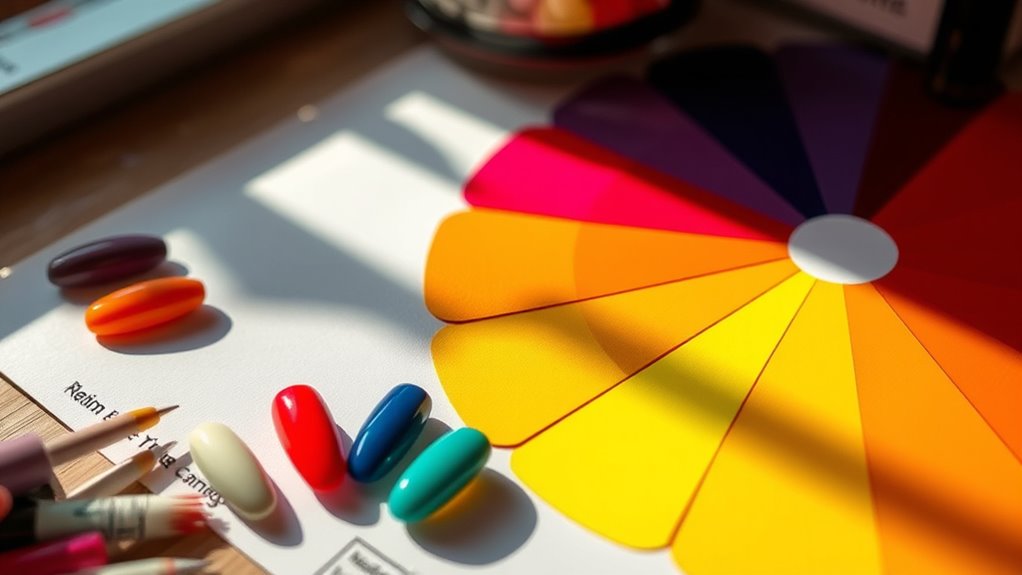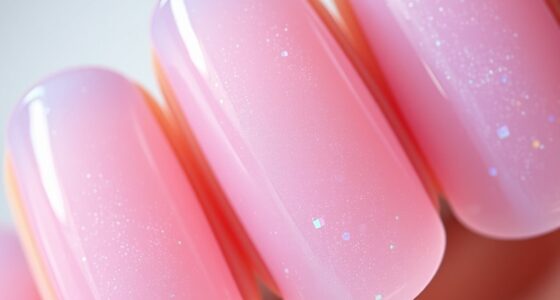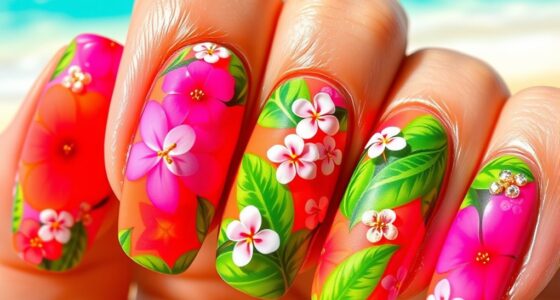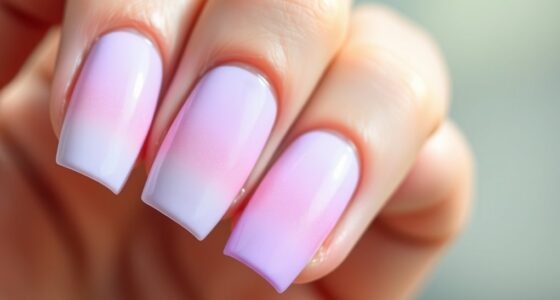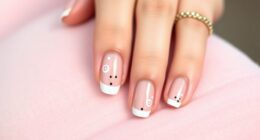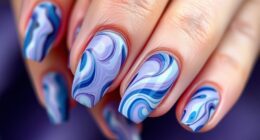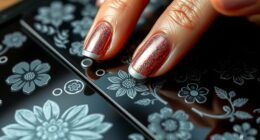Understanding color theory helps you create dynamic and harmonious nail art. Use the color wheel to choose complementary, analogous, or monochromatic schemes, balancing warm and cool tones for visual impact. Recognize how primary, secondary, and tertiary colors mix and how color psychology influences mood and perception. Incorporating these principles allows you to design eye-catching pieces with purpose. Keep exploring these basics, and you’ll continually improve your ability to craft stunning nail designs.
Key Takeaways
- Understanding the color wheel helps nail artists select complementary, analogous, and monochromatic schemes for cohesive designs.
- Primary, secondary, and tertiary colors form the foundation for creating diverse, harmonious nail color palettes.
- Using color contrast and harmony principles enhances visual interest and balance in nail art.
- Color psychology guides nail artists in choosing hues that evoke specific moods or messages.
- Practical tips like color blocking, metallic accents, and neutral balancing optimize overall nail design impact.
Understanding the Color Wheel

The color wheel is a fundamental tool that helps nail artists understand how colors interact and complement each other. It reveals how complementary contrast creates striking designs by pairing opposite colors, like blue and orange, for maximum impact. Recognizing warm cool balance is key to achieving harmony; warm tones like red and yellow contrast with cool shades like blue and green, creating visual interest without clashing. Additionally, understanding color harmony principles allows artists to develop more sophisticated and appealing designs. By mastering these concepts, you can craft nail art that stands out or appears balanced and cohesive. The wheel acts as your guide to mixing and matching colors intentionally, making your designs more dynamic. Understanding color theory basics empowers you to make confident, informed choices in your nail art projects. Moreover, exploring color contrast techniques can help you create more vibrant and eye-catching effects. Whether you want bold, contrasting looks or subtle, harmonious blends, understanding the color wheel empowers you to make confident, informed choices in your nail art projects.
Primary, Secondary, and Tertiary Colors

Building on your understanding of the color wheel, it’s important to recognize the basic categories of colors you’ll work with: primary, secondary, and tertiary. Primary colors—red, blue, and yellow—are the foundation for all color mixing. Secondary colors, created by mixing primaries, include orange, green, and purple. Tertiary colors result from blending a primary with a neighboring secondary, like red-orange or blue-green. These categories help you create a broad palette and understand color symbolism in nail art. Understanding color harmony can further improve your designs by combining colors effectively. Additionally, knowing how contrast ratios influence visual impact can help you select colors that enhance each other on nails. Recognizing the color wheel as a visual tool supports better color combinations and more cohesive nail art designs.
Color Harmonies and Combinations

Understanding how colors work together is essential for creating visually appealing nail art. One effective way to achieve harmony is by using complementary pairs—colors opposite each other on the color wheel, like blue and orange. These combinations create vibrant, eye-catching designs when balanced correctly. Another approach is monochromatic schemes, which involve using different shades, tints, and tones of a single color. This method produces sleek, sophisticated looks with subtle variation. Combining complementary pairs or sticking to monochromatic schemes allows you to craft nails that are both striking and cohesive. Experimenting with these color harmonies helps you develop a versatile palette, making your nail art designs more dynamic and visually engaging. Additionally, understanding color psychology can help you choose color schemes that evoke specific moods or feelings in your designs. Incorporating color theory principles can also inspire innovative and impactful nail art trends. Exploring sound healing science can further expand your creative horizons by understanding how specific color combinations influence mood and perception. Recognizing how color combinations can elicit emotional responses adds depth to your design choices.
The Psychology of Colors in Nail Art

Colors in nail art do more than just look good; they can influence moods and perceptions. The emotional impact of colors varies across individuals and cultures, making your choice significant. For example, red can evoke passion and energy, while blue promotes calmness and trust. Cultural symbolism also shapes color meaning—white often signifies purity in Western cultures but mourning in others. Understanding these nuances helps you create designs with intentional effects. Here’s a quick overview:
| Color | Emotional Impact | Cultural Symbolism |
|---|---|---|
| Red | Passion, excitement | Love, danger |
| Blue | Calm, trust | Loyalty, spirituality |
| Yellow | Happiness, optimism | Wealth, caution |
| Black | Power, sophistication | Mourning, elegance |
| White | Purity, simplicity | Peace, mourning |
Additionally, being aware of cultural differences in color symbolism can help you tailor your nail art to diverse clients and ensure your designs resonate across different cultural contexts. Recognizing that color psychology can vary widely is essential for creating meaningful and culturally sensitive nail art. Incorporating an understanding of predictive modeling in educational data mining can further enhance your ability to anticipate client preferences and trends over time.
Practical Tips for Applying Color Theory to Nail Designs

To effectively incorporate color theory into your nail designs, start by considering the mood or message you want to convey. Then, apply these practical tips:
- Use color blocking to create bold, contrasting sections that emphasize color harmony.
- Incorporate metallic accents to add a touch of glamour and highlight key areas.
- Stick to complementary or analogous colors for cohesive, eye-catching combinations.
- Balance vibrant hues with neutral shades to prevent overwhelming the design.
Frequently Asked Questions
How Do I Choose Colors That Complement Different Skin Tones?
When choosing colors that complement different skin tones, start with a skin tone analysis to understand undertones—cool, warm, or neutral. Use color contrast techniques to find shades that make your clients’ skin pop or create harmony. For lighter skin, try bold or pastel shades; for darker skin, rich, vibrant colors work beautifully. You’ll boost their confidence by selecting hues that enhance their natural beauty effortlessly.
Can Color Theory Help in Creating Trendy Nail Art Designs?
Think of creating trendy nail art as composing a symphony; color harmony and contrast are your instruments. When you use color harmony, your design feels balanced and soothing, like a well-tuned melody. Adding contrasting colors creates excitement and visual interest, much like a lively drumbeat. Yes, color theory guides you in mixing these elements, helping you craft eye-catching, fashionable designs that captivate and resonate with your audience effortlessly.
What Tools Are Best for Testing Color Combinations on Nails?
You should use a color wheel and swatch sticks to test color combinations effectively. The color wheel helps you understand complementary and analogous colors, guiding your choices. Swatch sticks allow you to see how colors look on nails before committing. By experimenting with different pairings on swatch sticks, you gain confidence in your selections, ensuring your nail art is trendy and visually appealing.
How Do Lighting Conditions Affect Nail Color Perception?
Did you know that 80% of color perception is influenced by lighting? Lighting impact considerably alters how you see nail colors, making shades appear different under various conditions. Bright, natural light reveals true hues, while dim or artificial lighting can distort color perception. As a nail artist, understanding this helps you choose colors better and ensures your clients see the actual shade, preventing miscommunication and ensuring satisfaction.
Are There Cultural Differences in Color Symbolism for Nail Art?
You might notice that cultural color meanings influence nail art preferences around the world. Different cultures assign unique symbolism to colors, impacting your clients’ choices and expectations. By understanding these cultural differences, you can stay ahead of global nail trends and create designs that resonate personally. Incorporating cultural awareness into your work helps you connect better with clients, ensuring your nail art feels meaningful and relevant across diverse backgrounds.
Conclusion
Now that you understand the basics of color theory, your nails become a vibrant canvas waiting to be explored. Picture your favorite shades blending seamlessly, creating eye-catching designs that reflect your personality. With this knowledge, you can confidently mix and match hues, turning simple nails into a stunning masterpiece. So, pick up your brushes, let your creativity flow, and watch your colorful vision come to life right at your fingertips.
